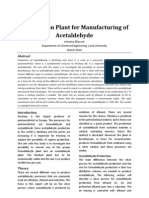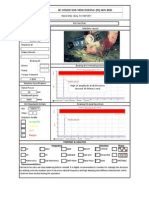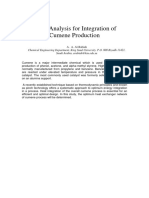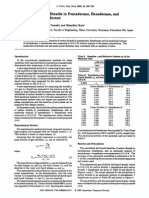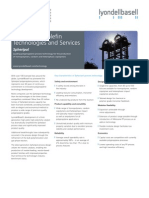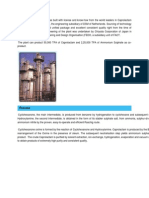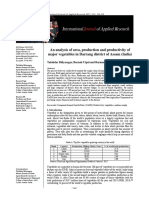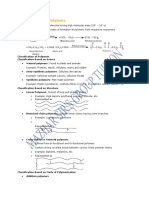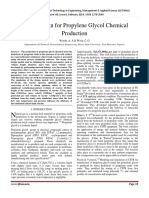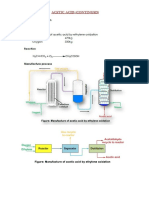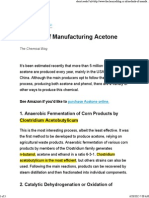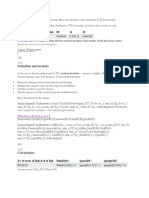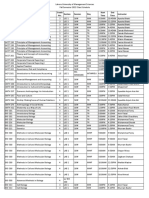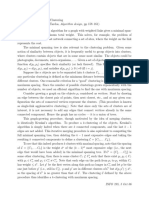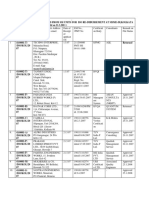Professional Documents
Culture Documents
New Catalysts For Selective Hydrogenation of Acetylene
New Catalysts For Selective Hydrogenation of Acetylene
Uploaded by
do_overOriginal Description:
Original Title
Copyright
Available Formats
Share this document
Did you find this document useful?
Is this content inappropriate?
Report this DocumentCopyright:
Available Formats
New Catalysts For Selective Hydrogenation of Acetylene
New Catalysts For Selective Hydrogenation of Acetylene
Uploaded by
do_overCopyright:
Available Formats
New catalysts for selective hydrogenation of acetylene: SCILL type systems
T. Herrmann, L. Rmann, M. Lucas, P. Claus Ernst-Berl-Institute/Technical Chemistry II TU Darmstadt, Petersenstrae 20, 64287 Darmstadt, Germany
Introduction Ethylene is worldwide one of the most important petrochemicals: its production exceeded 100106 t/a in 2008[1] and it is primarily used as a chemical building block for the production of plastics. Ethylene itself is mainly produced by thermal cracking of naphtha and the so obtained C2-cut contains trace impurities of acetylene which poisons the downstream polymerization catalysts. In commercial ethylene plants acetylene is removed by selective hydrogenation on Pd based catalysts. Ideally, this only leads to ethylene but in practice the formation of ethane and byproducts also occur. Rapid deactivation of the catalysts due to the formation of green oils, which partially cover the catalyst surface, therefore, still remains one of the main drawbacks in tail-end hydrogenation.[2] In recent years, ionic liquids attracted much attention as additives, solvents or catalyst coatings due to their non-volatility. SCILL catalysts for example show high activities and improved selectivities towards the intermediate product in semihydrogenation reactions of citral or COD.[3,4] The aim of this work was to expand this catalyst concept on the selective hydrogenation of acetylene under industrial conditions and to increase the selectivity to ethylene, thus reducing the formation of C4-hydrocarbons which act as precursors for green oil formation. Experimental Catalyst preparation: For the preparation of the SCILL catalysts industrial Pd-Ag shell catalysts were impregnated with ionic liquids via incipient wetness methods. Catalytic testing: The selective hydrogenation under tail-end conditions was carried out in a so-called monoline reactor developed in our laboratory which allows for the use of intact catalyst pellets (Figure 1). The reaction was carried out between 40 and 80 C and at a pressure of 10 bar. As reaction gas a typical tail-end acetylene/ethylene mixture was used (1 Vol% C2H2, H2, C3H8 each, 30 Vol% C2H4
in Ar). The analysis of the product gas was carried out online with a gaschromatograph (Hewlett Packard 5890 Series II).
SCILL catalyst
packing material
tubular reactor
heating shell
thermocouple
Teflon tube
Fig. 1: Catalyst alignment during the catalytic testing.
Results For the hydrogenation reaction Pd-Ag shell catalysts with different Pd:Ag ratios were impregnated with ionic liquids. During the preparation procedure the type of the IL and the loading were varied in a broad range. The activity measurements show that with increasing IL loadings the conversion rate of acetylene decreases roughly about one order of magnitude with reference to the untreated Pd-Ag shell catalyst. For shell catalysts with high Ag contents ionic liquids decrease the selectivity of C4hydrocarbons with increasing IL loadings, whereas for shell catalysts with low Ag content the ethylene selectivity is improved with increasing IL loadings.
[1]
H. Zimmermann, R. Walzl in: Ullmanns Encyclopedia of Industrial Chemistry, online Edition, VCH,
Weinheim, 2010, DOI: 10.1002/14356007.
[2] [3] [4]
A. Borodzinski, G.C. Bond, Catal. Rev. 2006, 48, 91. J. Arras, M. Steffan, Y. Shayeghi, P. Claus, Chem. Commun. 2008, 4058. U. Kernchen, B. Etzold, W. Korth, A. Jess, Chem.-Ing.-Tech. 2007, 79, 807.
You might also like
- Solution Polymerisation of StyreneDocument4 pagesSolution Polymerisation of StyreneMatthew Ong80% (5)
- Mononitration of TolueneDocument4 pagesMononitration of TolueneNur Syafiqah Izzuddin100% (1)
- Oxo Synthesis UlmannsDocument8 pagesOxo Synthesis UlmannsW00WNo ratings yet
- Kinetics of Catalytic Dehydrogenation of Ethylbenzene To StyreneDocument5 pagesKinetics of Catalytic Dehydrogenation of Ethylbenzene To Styreneibrahim3318No ratings yet
- Design of An Plant For Manufacturing of AcetaldehydeDocument4 pagesDesign of An Plant For Manufacturing of AcetaldehydeClaudio Martinez BernalNo ratings yet
- Vibration Sample Template PDFDocument1 pageVibration Sample Template PDFnumanfawzal67% (3)
- MSDS Uni Paint Marker PX-20 2Document2 pagesMSDS Uni Paint Marker PX-20 2pitichai_p100% (2)
- Modulus of Elasticity of PVB-2Document2 pagesModulus of Elasticity of PVB-2songyanxinNo ratings yet
- Pinch Analysis For Cumene ProductionDocument1 pagePinch Analysis For Cumene ProductionCarlos FrançaNo ratings yet
- Cumene PhenolDocument4 pagesCumene PhenolSushant SinhaNo ratings yet
- Solubility of Carbon Dioxide in Pentadecane, Hexadecane, and Pentadecane + HexadecaneDocument3 pagesSolubility of Carbon Dioxide in Pentadecane, Hexadecane, and Pentadecane + Hexadecanerezagholami87No ratings yet
- Spheripol Web ArtDocument2 pagesSpheripol Web ArtnahulaeNo ratings yet
- 2 Ethyl 2520hexanol IntroductionDocument1 page2 Ethyl 2520hexanol Introductionapi-3714811100% (1)
- Molecular Weight of Carbopol and PemulenDocument3 pagesMolecular Weight of Carbopol and PemulenMawarniNo ratings yet
- Facts at Your Fingertips: Catalysis FundamentalsDocument1 pageFacts at Your Fingertips: Catalysis Fundamentalsjdgh1986No ratings yet
- Synthesis of PetrochemicalsDocument9 pagesSynthesis of PetrochemicalsAnoop UchagawkarNo ratings yet
- Activation Catalytic EnglishDocument1 pageActivation Catalytic EnglishplennyNo ratings yet
- FACT Caprolactam Plant Was Built With License and KnowDocument2 pagesFACT Caprolactam Plant Was Built With License and KnowmaanwarNo ratings yet
- AnDocument4 pagesAnBidyasagar TalukdarNo ratings yet
- Lecture 18 Ethylene GlycolDocument6 pagesLecture 18 Ethylene GlycolJayraj DaymaNo ratings yet
- Vander Waa Ls ConstantsDocument1 pageVander Waa Ls ConstantsSaurabh MishraNo ratings yet
- Oxidation of O-Xylene To Phthalic Anhydride - Chempedia - LookChemDocument2 pagesOxidation of O-Xylene To Phthalic Anhydride - Chempedia - LookChemAnilKumarNo ratings yet
- Parametri Per L'equazione Di Antoine Ed Altre ProprietàDocument1 pageParametri Per L'equazione Di Antoine Ed Altre ProprietàAlberto NovelloNo ratings yet
- Manufacturing of StyreneDocument1 pageManufacturing of StyreneNornadiahnadhirah MdNadzriNo ratings yet
- Simulation and Analysis of A Reactive Distillation Column For Removal of Water From Ethanol Water MixturesDocument9 pagesSimulation and Analysis of A Reactive Distillation Column For Removal of Water From Ethanol Water MixturesBryanJianNo ratings yet
- Hostalen Brochure PDFDocument2 pagesHostalen Brochure PDFRebecca LimbardoNo ratings yet
- Progress in Synthesis of Ethylene Glycol Through C1 ChemicalDocument10 pagesProgress in Synthesis of Ethylene Glycol Through C1 ChemicalFelipe A. Peña RincónNo ratings yet
- Report 0Document19 pagesReport 0Joseph OrjiNo ratings yet
- AlkylationDocument8 pagesAlkylationMohammad AlMousaNo ratings yet
- UntitledDocument12 pagesUntitledapi-256504985No ratings yet
- Polymer SolutionsDocument4 pagesPolymer SolutionsSankhya MohantyNo ratings yet
- CHE171 - Kinetics 1Document1 pageCHE171 - Kinetics 1JannineNo ratings yet
- Petrochemical IndustryDocument30 pagesPetrochemical Industrybuhayche14No ratings yet
- Cumene Production PlantDocument6 pagesCumene Production PlantMertcan AslanNo ratings yet
- Oxo Alcohols - IndiaDocument7 pagesOxo Alcohols - Indiascribd405No ratings yet
- Spent Acid From Nitration of TolueneDocument2 pagesSpent Acid From Nitration of TolueneacckypenrynNo ratings yet
- Petrochemical Engineering - II Unit - V: Aromatics-BTX DerivativesDocument25 pagesPetrochemical Engineering - II Unit - V: Aromatics-BTX DerivativesAnilKumarNo ratings yet
- Synthesis of PMMADocument5 pagesSynthesis of PMMATe-greg MillerNo ratings yet
- About Acetic Acid MarketDocument3 pagesAbout Acetic Acid MarketNoranierahNohoNo ratings yet
- ch-15 NcertDocument9 pagesch-15 NcertTr Mazhar PunjabiNo ratings yet
- Msds Stearic AcidDocument6 pagesMsds Stearic AcidSanggari MogarajaNo ratings yet
- Group Acetic Acid PresentationDocument24 pagesGroup Acetic Acid PresentationNatko47No ratings yet
- Ullmann's Enc. of Industrial Chemistry PLANTA.Document12 pagesUllmann's Enc. of Industrial Chemistry PLANTA.yoelarismendi100% (1)
- Econoimcs of Acetic Acid Concentration Produced From Partial Oxidation of Ethane PDFDocument8 pagesEconoimcs of Acetic Acid Concentration Produced From Partial Oxidation of Ethane PDFJames EdwardsNo ratings yet
- Hydroformylation of PropyleneDocument4 pagesHydroformylation of Propylenemichelle_tang_9No ratings yet
- Styrene From Ethane and BenzeneDocument6 pagesStyrene From Ethane and BenzeneAmy Puah100% (2)
- CSTR Design For Propylene Glycol Chemical ProductionDocument13 pagesCSTR Design For Propylene Glycol Chemical ProductionMeilani Kusuma WatiNo ratings yet
- Lecture 1: Petrochemicals: OverviewDocument9 pagesLecture 1: Petrochemicals: Overviewمرتضى كاظم غانمNo ratings yet
- Project 2Document56 pagesProject 2Parth ShahNo ratings yet
- Lecture 4Document8 pagesLecture 4AbbasNo ratings yet
- Manufacturing AcetoneDocument3 pagesManufacturing AcetoneSiran Marayo100% (1)
- Preparation of Nylon by Condensation PolymerizationDocument9 pagesPreparation of Nylon by Condensation PolymerizationWei NianNo ratings yet
- Solubility Parameter Cellulose Esters PDFDocument3 pagesSolubility Parameter Cellulose Esters PDFcaioltbgNo ratings yet
- Ether ProjectDocument22 pagesEther ProjectekojamichaelNo ratings yet
- Arrieta Ethylene GlycolDocument8 pagesArrieta Ethylene GlycolNguyen VietNo ratings yet
- Production of Pure Hydrogen by Ethanol DehydrogenationDocument9 pagesProduction of Pure Hydrogen by Ethanol DehydrogenationAbdulwahid SultanNo ratings yet
- Church 1951Document8 pagesChurch 1951Evan DulayNo ratings yet
- 18-7-14 Litrature - Fatty AlcoholDocument7 pages18-7-14 Litrature - Fatty AlcoholAkash PagareNo ratings yet
- Inui 2002Document9 pagesInui 2002Rohit BabelNo ratings yet
- Acetaldehyde Production From Ethanol Over Ni-Based CatalystsDocument7 pagesAcetaldehyde Production From Ethanol Over Ni-Based CatalystsyigitilgazNo ratings yet
- Production of AcetaldehydeDocument124 pagesProduction of AcetaldehydeAdilaAnbreen80% (5)
- EquilibriumDocument7 pagesEquilibriumPassmore DubeNo ratings yet
- Nanoindentation of Marine Teeth Studing Dentin and Enameloid in Dry and Hydrated Conditions App Note BRUKERDocument3 pagesNanoindentation of Marine Teeth Studing Dentin and Enameloid in Dry and Hydrated Conditions App Note BRUKERRani PanggabeanNo ratings yet
- Abb Machinery Drives Catalog Acs850Document24 pagesAbb Machinery Drives Catalog Acs850Neeraj RaushanNo ratings yet
- Document Transmittal: Pt. Techno Orbit Particle FiltrationDocument1 pageDocument Transmittal: Pt. Techno Orbit Particle FiltrationUrdian syahNo ratings yet
- HR Business PArtnerDocument3 pagesHR Business PArtnerUpendra bhatiNo ratings yet
- Entry of Foreign ArchitectsDocument26 pagesEntry of Foreign ArchitectsSajju ArunachalamNo ratings yet
- 14 - Appendix MSD PDFDocument43 pages14 - Appendix MSD PDFNanban MadhavanNo ratings yet
- CVALEJANDROMartin Del Campo MorenoDocument3 pagesCVALEJANDROMartin Del Campo MorenoSoluciones Capital HumanoNo ratings yet
- Multilog LX Installation User Guide (PDF - Io)Document61 pagesMultilog LX Installation User Guide (PDF - Io)Guy SansiriNo ratings yet
- Lab 2 Hydraulic Fluid PowerDocument20 pagesLab 2 Hydraulic Fluid PowerHanisahKhalilNo ratings yet
- Gas Exchange in PlantsDocument6 pagesGas Exchange in PlantsAbi RNo ratings yet
- Mamolino 20M-2S Brochure 12.2012 Light PDFDocument5 pagesMamolino 20M-2S Brochure 12.2012 Light PDFAnthony H TLNo ratings yet
- 12 - HUMSS and STEM Ne Edit Na TotooDocument10 pages12 - HUMSS and STEM Ne Edit Na TotooFreya GandaNo ratings yet
- Standard Diviation of Discrete Random VariableDocument2 pagesStandard Diviation of Discrete Random VariableLilibeth ReyesNo ratings yet
- Fall Semester 2022 Class ScheduleDocument18 pagesFall Semester 2022 Class ScheduleMuhammadMahdiKhanNo ratings yet
- Assignment 1 HTT170Document43 pagesAssignment 1 HTT170NIK NUR ALEYLIYANA NABILAH ZULKARNAINNo ratings yet
- Error Al Autorizar Un MenuDocument4 pagesError Al Autorizar Un MenuSantiago Carrascal ArchilaNo ratings yet
- Buoyancy For Hs PDFDocument2 pagesBuoyancy For Hs PDFJOYDEEP DASGUPTANo ratings yet
- Kruskal and ClusteringDocument1 pageKruskal and ClusteringHadi FouaniNo ratings yet
- Samsung 743 943n-schDocument8 pagesSamsung 743 943n-schAno_NimskaNo ratings yet
- (G2) Describing Learning & TeachingDocument30 pages(G2) Describing Learning & TeachingNguyễn Trần Bá ToànNo ratings yet
- Leadership PDFDocument6 pagesLeadership PDFbjhbfjhNo ratings yet
- Ms Me KolkataDocument34 pagesMs Me Kolkataudiptya_papai2007No ratings yet
- Balanced Reading ProgramDocument4 pagesBalanced Reading ProgramJannin BautistaNo ratings yet
- GeneticsDocument4 pagesGeneticsLali HajzeriNo ratings yet
- Graham Roberts-Phelps - Companies Don't Succeed People Do! - Ideas To Create Profits Through People PDFDocument199 pagesGraham Roberts-Phelps - Companies Don't Succeed People Do! - Ideas To Create Profits Through People PDFIvo VulićNo ratings yet
- CematrixDocument379 pagesCematrixAHNo ratings yet
- Reasoning QuestionsDocument3 pagesReasoning QuestionsKashif RazaNo ratings yet




